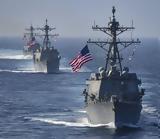US Navy: Lasers, Rail Guns and Missiles – The Future Is Clear
The U.S. Navy’s Chief of Naval Operations Adm. Mike Gilday outlined what he would like to see come out of American shipyards. Ideally the new ships would be able to pack more anti-ship missiles onboard than the Navy’s Arleigh Burke guided-missile destroyers are able to carry, and wouldn’t be as large as the stealthy 610-foot Zumwalt-class guided missile destroyers.
The new class
In addition to the new class’ more compact size, the Navy is hopeful that directed energy weapons—lasers or railguns—will have a place onboard. Though the technology is not yet mature, the Navy has high hopes for directed energy weapons which they anticipate will drastically increase ship survivability—if the energy-intensive weapons can be successfully mated to ships.
In anticipation of the high energy requirements directed energy weapons would require, the Navy may move to integrate a high-output electrical power system onboard. One solution could be the Zumwalt-class’ Integrated Power System that converts mechanical energy to electrical energy in order to power onboard electronics.
A 355 Ship Navy
China recently surpassed the United States Navy as the world’s largest. In an effort to mitigate the imbalance and threat posed by a large Chinese Navy, the United States Navy would like to increase the number of ships available.
The Zumwalt-class was supposed to be thirty-two hulls in total, though due to astronomical cost overruns, the class was ultimately limited to only three hulls. This has led to an increased reliance on the Navy’s late-Cold War era Arleigh Burke-class guided missile destroyers.
Though capable when first introduced in the early 1990s, the class has grown somewhat long in the tooth. The most advanced of the Arleigh Burke-class, the DDG Flight IIIs are still being built today. While they feature improved radars, questions have been raised about the survivability of a late 1980s ship design against modern naval threats, in particular increasingly lethal stand-off missiles. One of the class’ additional limitations is an inadequate amount of electrical power generation for the Navy’s future weapons, be they railguns or lasers.
Source: nationalinterest.org
The post US Navy: Lasers, Rail Guns and Missiles – The Future Is Clear appeared first on ARMYNOW.NET.
- Δημοφιλέστερες Ειδήσεις Κατηγορίας Blogs
- Κορονοϊός στην Ελλάδα: Έτσι θα φοράμε μάσκα στα καταστήματα εστίασης
- Ιρίνα Σάικ: Τρέλανε το Instagram με τα... ατελείωτα πόδια της - ΦΩΤΟ
- ΑΝΑΔΡΟΜΙΚΑ ΣΥΝΤΑΞΙΟΥΧΩΝ: Πόσα παίρνουμε στις συντάξεις Νοεμβρίου ΙΚΑ 2020
- Φόβοι για επιβεβαίωση του κακού σεναρίου
- Δίκη Χρυσής Αυγής: Πρώτα καραντίνα και μετά στα κελιά! Πόσο θα κάτσουν στη φυλακή
- Αυξήσεις και εκπλήξεις: Επικουρικές συντάξεις ΙΚΑ Νοεμβρίου- Αναδρομικά ΕΦΚΑ ΟΠΕΚΕΠΕ
- Νέα δημοσκόπηση: Ποια η διαφορά ΝΔ-ΣΥΡΙΖΑ - Τι απαντούν οι πολίτες για το εμβόλιο κατά του κορονοϊού
- Αλλάζει η ώρα τα ξημερώματα της κυριακής
- ΝΕΟΣ ΔΙΑΣΥΡΜΟΣ για τον Μπακογιάννη! ΦΥΤΕΨΑΝ... κάνναβη στις ζαρντινιέρες του «Μεγάλου Περιπάτου»
- ΠΡΟΣΩΠΑ ΚΑΙ ΠΟΣΟΣΤΑ! ΤΙ ΔΕΙΧΝΕΙ νέα δημοσκόπηση...
- Δημοφιλέστερες Ειδήσεις Armynow

- Τελευταία Νέα Armynow
- US Navy: Lasers, Rail Guns and Missiles – The Future Is Clear
- War To Continue in Nagorno-Karabakh Until Turkey’s Appetite Is Suppressed
- Turkey extends Oruç Reis’ activities until October 27
- Germany refuses Greek request to end weapon exports to Turkey despite threats of war
- Psych Hub Veteran Mental Health Resources
- America Has No Duty to Rule the World
- NATO Deputy Secretary General highlights education and training as key to adaptation to future challenges
- Greece may acquire four warships through joint production with the US
- BAE Systems, Elbit Systems of America team to shape the future of Army combat vehicles
- Leaders of Greece, Cyprus & Egypt call out Turkish provocations in trilateral press conference
- Τελευταία Νέα Κατηγορίας Blogs
- Χρυσή Αυγή: Ψάχνουν παντού τον Παππά – «Δεν παραδίνομαι»
- Ο Πούτιν «κλείνει το μάτι» στην Ελλάδα! Έρχεται Αθήνα ο «τσάρος»; Εκνευρισμένος ο Ερντογάν
- Εορτολόγιο 23 Οκτωβρίου: Ποιοι γιορτάζουν σήμερα
- 28η Οκτωβρίου 1940 – Το Μεγάλο Θαύμα της Παναγίας!
- Τι είναι η αρχαιοπρεπής θεία λειτουργία Αγίου Ιακώβου Αδελφόθεου
- Αλλαγές στο χάρτη υγειονομικής ασφάλειας – Οι περιοχές που ανέβηκαν σε επίπεδο κινδύνου
- Κορονοϊός: Το σχέδιο Μητσοτάκη για το κυβερνητικό repeat στη δεύτερη φάση της πανδημίας
- Αυξήσεις και εκπλήξεις: Επικουρικές συντάξεις ΙΚΑ Νοεμβρίου- Αναδρομικά ΕΦΚΑ ΟΠΕΚΕΠΕ
- Κορονοϊός: Κρίσιμα τα επόμενα 24ωρα για την έξαρση – Πόσο πιθανό είναι το γενικό lockdown
- Τα 281 σχολεία ή τμήματα στα οποία τέθηκε απαγόρευση λειτουργίας λόγω κρουσμάτων Κορωνοϊού - (Συνεχής Ενημέρωση από το esos)



